Midland Radio 75440 2 W UHF Radio User Manual 70 440BP User s Manual
Midland Radio Corporation 2 W UHF Radio 70 440BP User s Manual
Contents
- 1. 8
- 2. revised manual
revised manual
70-440BP
UHF Handheld Transceiver
User’s Manual
Copyright © 2002 by Midland Radio; all rights reserved.
In this book…
IN THIS
BOOK….................................................................................................................................................2
WARNING
NOTES.................................................................................................................................................3
FCC LICENSING
INFORMATION............................................................................................................................3
SAFETY............................................................................................................................................................
....3
CONVENTIONS AND SYMBOLS IN THIS
BOOK.......................................................................................................5
PART NAMES AND THEIR
FUNCTIONS......................................................................................................6
TOP..................................................................................................................................................................
....6
FRONT.............................................................................................................................................................
.....6
SIDE (LEFT AND
RIGHT)........................................................................................................................................7
DISPLAY..........................................................................................................................................................
.....7
SETUP...............................................................................................................................................................
.....8
UNPACKING.....................................................................................................................................................
....8
FITTING AND REMOVING THE
ANTENNA...............................................................................................................9
INSTALLING AND REMOVING THE BATTERY
PACK................................................................................................9
INSTALLING/REMOVING THE BELT
CLIP..............................................................................................................10
CHARGING THE BATTERY
PACK..........................................................................................................................10
BASIC
OPERATIONS.......................................................................................................................................11
SWITCHING THE RADIO ON AND
OFF................................................................................................................11
ADJUSTING
VOLUME..........................................................................................................................................12
CHANNEL
SELECTION.........................................................................................................................................12
RECEIVING.......................................................................................................................................................
..12
MONITOR
BUTTON.............................................................................................................................................12
TRANSMITTING................................................................................................................................................
..13
ADJUSTING TRANSMIT
POWER...........................................................................................................................13
SCANNING
CHANNELS........................................................................................................................................14
RADIO
LOCK.......................................................................................................................................................15
ADVANCED
OPERATIONS............................................................................................................................16
HANDSFREE TRANSMIT
(VOX)..........................................................................................................................16
PAGING
CALL.....................................................................................................................................................16
ROGER
BEEP......................................................................................................................................................17
KEY
BEEP..........................................................................................................................................................17
BATTERY
PACKS................................................................................................................................................17
RADIO
MAINTENANCE........................................................................................................................................18
OPTIONAL
ACCESSORIES............................................................................................................................19
QUICK
REFERENCE.......................................................................................................................................21
OPERATION
REFERENCE.....................................................................................................................................21
INDEX...............................................................................................................................................................
...22
Introduction
Congratulations. 70-440BP is an advanced Professional Radio. Its rugged design allows it to be
your reliable partner even during hard working days. Its LCD as well as user friendly controls
make the 70-440BP easy to use.
To extend the flexibility of the radio, a “VOX” (Voice Operated Transmit) function has been added
which allows switching the transmission just by talking in full hands free condition (with optional
headset).
Transceiver’s specifications provided in 70-440BP are compliant with EIA/TIA 603 and ETS 300
086, The 70-440BP top level design and resistance are compliant with IEC529 level IP54 and MIL
STD 810 C,D,E.
Midland Radio is committed to continuous quality improvements, for this reason specifications
may vary without prior notice.
Warning notes
Every effort has been made to ensure that the information in this document is complete, accurate,
and up-to-date. Midland Radio assumes no responsibility for the results of errors beyond its
control. The manufacturer of this equipment also cannot guarantee that changes in the equipment
made by non authorized people will not affect the applicability of the information in it.
FCC Licensing Information
This Midland model 70-440BP radio operates on frequencies which require a license from the
Federal Communications Commission (FCC) for business, personal, and recreational use.
For questions concerning licensing, contact the FCC at 1-888-CALL-FCC (1-888-225-5322), or
go to http://www.fcc.gov.
Safety
Your 70-440BP handheld transceiver has been carefully designed to give you years of safe,
reliable performance. As with all electrical equipment, however, there are a few basic precautions
you should take to avoid hurting yourself or damaging the radio:
• Read the instructions in this handbook carefully. Be sure to save it for future reference.
• Read and follow all warning and instruction labels on the radio itself.
• Do not carry the transceiver by the antenna. This may damage the antenna or antenna
terminal. Grasp it by its base (not the tip!) when you need to place or remove it.
• Do not keep the radio with the antenna very close to, or touching exposed parts of the body,
while transmitting. The radio will perform best if the microphone is 5-10 cm away from the
mouth and the radio is vertical.
• Be sure the “PTT” key is not pressed when you do not need to transmit.
• Do not operate the radio near unshielded electrical blasting caps or in an explosive atmosphere.
• Do not transmit without the antenna fitted on the radio. Though it is provided with a
protection, it may damage the TX output final stage.
• Respect the environment conditions. The radio is designed to be used in heavy
environments, however avoid exposing it to extremely hot or cold temperature (out of the
range between –30 to +60°C). Do not expose the transceiver to excessive vibrations as well
as dusty or rainy places.
• Never try to disassemble or service the radio by yourself (aside from the routine
maintenance described in this handbook). It will immediately void the warranty and you may
cause damage requiring extensive repair work. Always contact your local dealer for
assistance.
• Use only authorized accessories. Non original ones could seriously damage your handheld
transceiver.
• Do Not spill liquid of any kind into your radio. If the transceiver gets wet, immediately dry it
by a soft and clean cloth.
• Switch the radio off before you clean it. Strictly follow the directions described in the
paragraph “Care and maintenance”.
• Handle the battery properly. Strictly follow the directions reported in “Care and maintenance”.
• Be certain that your power source matches the rating listed for the supplied battery charger (AC
adapter). If you are not sure, check with your dealer.
• To avoid damaging the power cable of the battery charger, do not put anything on it or place it
where it will be walked on.
This product complies with the requirements of the Council Directives 89/336/EEC and
73/23/EEC on the approximation of the laws of the member states relating to electromagnetic
compatibility and low voltage.
∆ WARNING
This radio is intended for occupational use where the user is trained in the operation of devices
that cause exposure to RF electromagnetic energy. This radio is not intended for use by the
general public.
To ensure that your exposure to RF electromagnetic energy is within the FCC allowable limits for
occupational use, always adhere to the following guidelines:
DO NOT operate the radio without a proper antenna attached, as this may damage the radio and
may also cause you to exceed FCC RF exposure limits. A proper antenna is the antenna supplied
with this radio by the manufacturer or an antenna specifically authorized by the manufacturer to
use with this radio.
DO NOT transmit for more than 50% of the total radio use time (if you transmit 10% of the time,
you must be in standby 10% of the time). Transmitting more than 50% of the time can cause FCC
RF exposure compliance requirements to be exceeded. The radio is transmitting when the "TX
indicator" lights red. You can cause the radio to transmit by Pressing the "PTT" switch. ALWAYS
use authorized accessories (antenna, batteries, etc).Use of unauthorized accessories can cause
the FCC RF exposure compliance requirements to be exceeded. To maintain compliance with the
FCC's RF exposure guidelines, this transmitter and it’s antenna must maintain a separation
distance of least 2 inches (5 centimeters) from your body
Conventions and Symbols in this Book
This symbol marks a ‘note’. Notes are hints or tips which offer additional information to help
you.
This symbol marks a ‘caution’. Cautions are special notices, which you should read and
follow carefully to avoid possible damage to your equipment and to avoid potential
danger to yourself or other people.
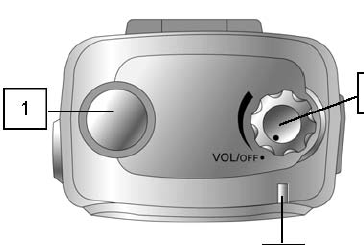
Key names will be highlighted in bold.
Important sentences and words are highlighted in Italic.
Part Names and their functions
Please have a look at the following parts description in order to familiarize yourself with the
transceiver’s main parts and controls. Numbers in brackets refer to the illustration.
Top
[1] Antenna connector. Fit the antenna to this connector (MX thread type).
[2] Power ON/OFF knob. Rotate this knob to turn the transceiver on and off.
[3] Status LED. Glows in different colors to show the radio’s current status.
Front
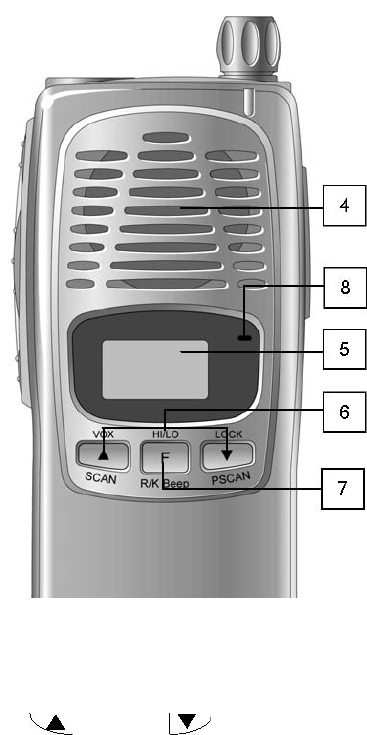
[4] Speaker. The built in speaker located in this point emits the received sound.
[5] LCD display. Shows the radio’s parameters (channel number etc.). Icon and symbols are
further explained in the paragraph “Display”. Whenever any key or button is pressed, the
display is automatically backlit for few seconds.
[6] (Up) and (down) buttons. For scrolling forward and backward through the channel
list and for changing function values.
[7] “FUNC” button. Allows changing function values.
[8] Microphone. Your voice is detected by the microphone located in this place
1
5
4
8
7
6
3
2
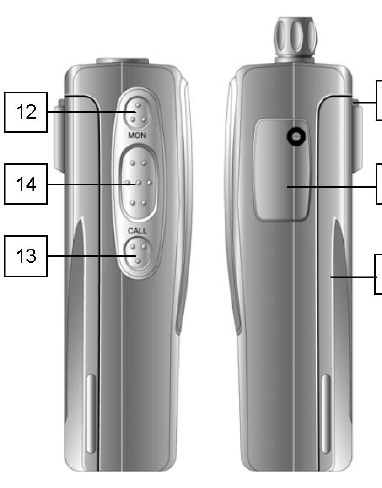
Side (left and right)
[9] Microphone connector. For remote speaker/microphone, headsets for VOX use and other
accessories. It must be protected with the supplied plastic cap when not in use. For the
related pin connections please see to “Microphone connection”.
[10] Battery pack. This NiMH battery pack supplies energy to your radio.
[11] Release button (located on the battery’s body). Allows to remove the battery pack
[12] MON (monitor) button. Enables the loudspeaker for monitoring of the tuned channel when
CTCSS/DCS is enabled.
[13] “CALL” button. Sends a paging “CALL” (if enabled)
[14] “PTT” (Push To Talk) button. When pressed switches the transceiver from receive to
transmit.
Display
This section explains the meaning of the various indications that may appear on the LCD of your
70-440BP handheld transceiver:
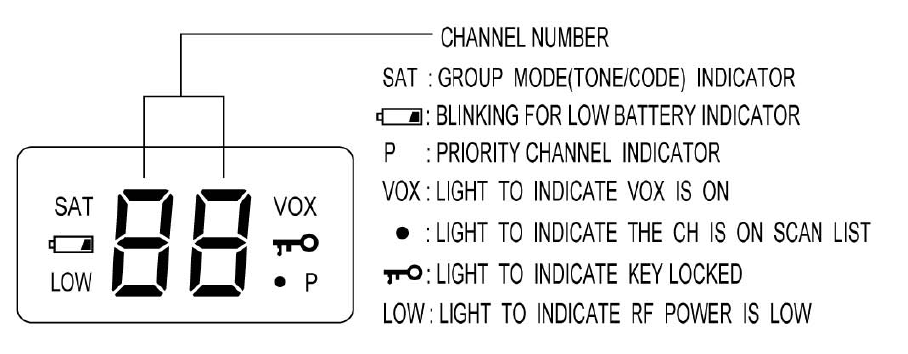
13
14
12
11
10
9
Setup
Unpacking
The following items are in the package:
(a) Transceiver’s main body
(b) Flexible antenna
(c) Battery pack NiMH 1,300 mA/h
(d) Belt clip
(e) Users guide (this book!)
If something is missing please promptly advise your supplier.
Fitting and removing the Antenna
To fit the antenna:
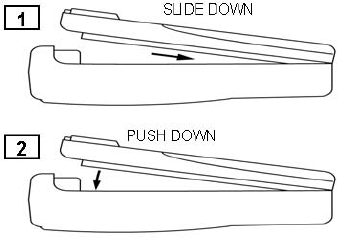
1) Locate the antenna terminal (thread MX type) on transceiver’s top.
2) Hold the transceiver with one hand and the base (the thicker part) of the antenna with the
other.
3) Attach the included rubber duck antenna to the antenna terminal by turning it clockwise until it
is firmly locked. Do not overtighten.
To remove the antenna do the same described procedure. At step 3 turn the antenna base
counterclockwise.
Always have the antenna attached to the radio. You can not communicate without it.
Transmitting without the antenna will damage the TX output final stage. For the same
reason use only the supplied antenna.
Installing and removing the battery pack
To install the battery pack:
1) Hold the transceiver’s body with one hand and the battery pack with the other. Put the bottom
edge of the battery pack onto the bottom of the transceiver.
2) Gently push the battery pack toward the transceiver’s body until the battery latches.
To remove the battery pack:
1) Press the battery release button located in the top of the battery pack.
2) Keep the button pressed and gently pull the battery pack away from the transceivers body.
3) Remove the battery pack by separating it from the transceiver’s body.
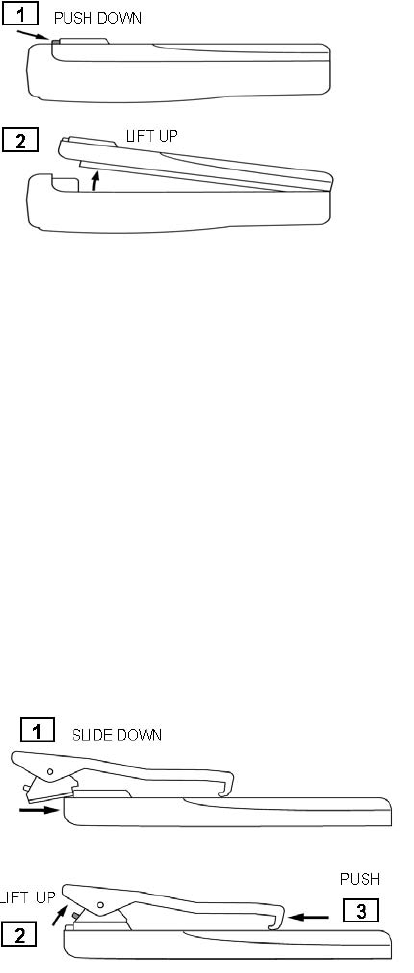
2
1
PUSH DOWN
SLIDE DOWN
2
1
LIFT UP
PUSH DOWN
Installing/removing the belt clip
The supplied belt clip allows you to hang the transceiver on your belt or jacket when you are not
using the radio.
To fit the belt clip onto the transceiver’s body:
1) Gently slide the clip into the appropriate guides located on the transceiver’s battery pack until it
firmly locks.
To remove the belt clip:
2) Gently move the latch located between the top of the belt clip and the battery pack towards the
belt clip
3) Slide the belt clip off the radio.
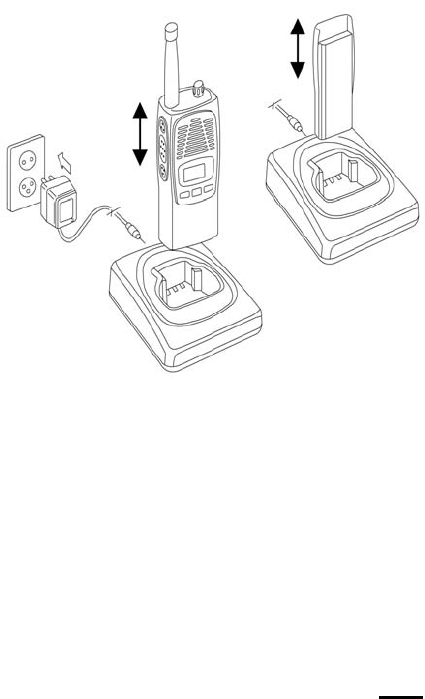
Charging the battery pack
To charge the supplied battery pack you have to setup the charger and connect the radio as
follows:
1) Connect the jack coming from the AC adapter to the cradle’s socket.
3) Connect the AC plug of the AC adapter’s power cable into a grounded AC power outlet.
4) Ensure that the radio is switched off.
5) Insert the radio into the cradle with the keypad toward you (the three metallic contacts of the
battery pack must touch with the three contacts inside the cradle).
6) Wait 10-12 hours with the standard charger 2 hours with the rapid charger and remove the
radio..
Do not remove the radio before the specified time, otherwise the battery’s duty could be
temporarily reduced.
Do not forget to remove the radio from slow charger after 10 to 12 hours.
The battery charger is for indoor use only.
For the next charges, best duty and battery life please see the chapter “Battery Packs”.
PUSH
LIFT UP
SLIDE DOWN
3
2
1
Basic Operations
Switching the radio ON and OFF
To switch the radio on:
1) Rotate the “PWR/VOL” knob clockwise until the radio is switched on. The CPU will start an
auto test as follows:
• LED will glow GREEN, then RED and turn OFF.
• LCD will display all segments and icons. The letters "PS"("PASS") will be displayed followed
by a long beep.
• LCD will display the last operating mode.
The self-test goes very fast.
2) After the auto test has been carried out LCD will show the following data:
• The channel number. (2 numeric characters).
NOTE: About 0.5 second after you select a new channel or change operation mode, the last
status is automatically saved. When the Radio is turned on, the most recently used channel
is displayed.
NOTE: the following icons will be displayed depending on the operating mode.
• The currently selected TX output power: LOW for low or nothing for high in the lower left
corner of the LCD.
• A small “•” is displayed in the lower right corner of the LCD if the channel is in the SCAN
list. (if enabled)
• A “P” is displayed to show that the channel is in the priority Scan list. ( if enabled)
• “SAT” in the upper left corner indicates that the channel is a GROUP CHANNEL (for
CTCSS or DCS tone if enabled).
• “Battery” icon when visible indicates battery is low.
• “VOX” is displayed when “VOX” function is enabled.
• A “Key” icon to indicate that the keypad is locked.
NOTE: When “VOX” is enabled, ““PTT”” button is not working.
NOTE: When keypad is locked; only “PTT” button is enabled (with exception of VOX
enabled).
To switch the radio off, rotate the PWR/VOL knob counterclockwise.
Adjusting volume
The PWR/VOL knob is used to adjust the RX volume: turn it clockwise to increase or
counterclockwise to reduce it.
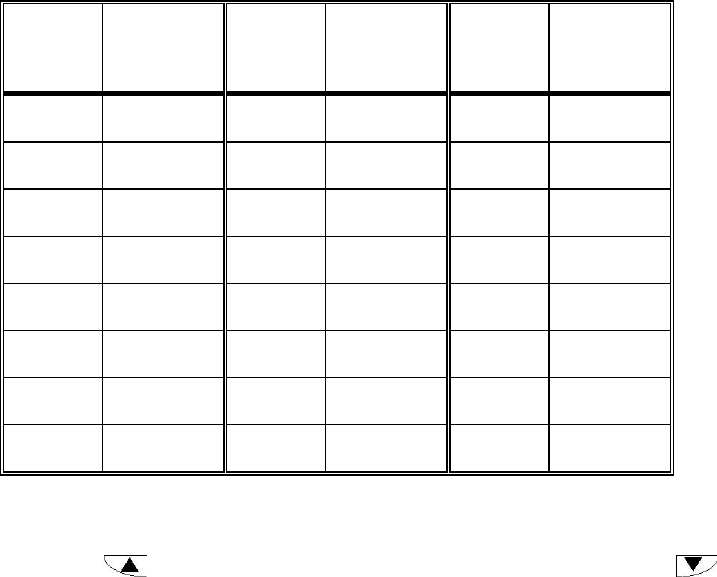
Channel selection
Each channel is identified by 2 numeric digits.
Channel
Freq. MHz. Channel Freq. MHz. Channel
Freq. MHz.
To select a channel:
1) Press the key to increase the channel number or the key to
decrease it.
Receiving
Your radio can be programmed to work, channel by channel, in “Open traffic” or “GROUP MODE
(CTCSS/DCS)”. Group mode prevents other users of a channel from being heard on your radio.
See “Setting Group Mode Codes” for programming instructions.
• OPEN TRAFFIC: in this case you will hear all communication which will be transmitted on the
selected channel. When a message is received your squelch will un-mute, you will see the
status LED glowing green and you will hear the message.
• GROUP MODE:
• CTCSS/DCS (Continuous Tone Code Squelch System / Digital Coded Squelch): are
systems which use particular TX signaling as an access “key” to work a repeater
(encoder) or to unlock the party’s signaling sensitive squelch. This last condition allows
more radio networks to share the same frequency. In this case you will receive only
messages coming from parties sending a proper TX signaling. During “CTCSS/DCS”
operation, the radio may be set-up so that the appropriate CTCSS/DCS decoder enables
the speaker.
CTCSS/DCS If more than one station is transmitting at the same time, this will cause
interference! Do not transmit if the status LED is glowing. Wait until the channel is
clear before transmitting.
Monitor Button
The Monitor button can enable or disable “GROUP MODE (CTCSS/DCS)” if programmed for that
channel.
1) To enable “GROUP MODE”. Press and release the“MON” button: “SAT” icon is displayed. A
Sub Audible Tone mutes your speaker.
2) To Disable “GROUP MODE”. Press the “MON” button: “SAT” icon is not displayed. You are
now working in “Open Traffic”.
NOTE: if “SAT” icon is never displayed, “CTCSS/DCS” tone is not programmed.
“GROUP MODE” function is not available.
3) Press and Hold “MON” button for three seconds, internal squelch will be disabled and your
speaker is un-muted. Press and release the “MON” button to restore the squelch to normal
operating condition.
Transmitting
1) Ensure that the channel is not busy otherwise you will create interference.
2) Press the “PTT” button, the status LED will glow red.
3) Start talking at a normal voice level at approximately 2.5 inches from the microphone (keep
the “PTT” button pressed).
4) When you have finished talking, release the “PTT” button.
Do not shout! It will not increase the distance you can transmit, but rather will make you
heard distorted.
Do not release the “PTT” button before your message is over or start talking before
pressing “PTT”, otherwise your message will be “chopped”.
A handheld radio does not allow you to talk and receive simultaneously, for this reason
make your messages short. When you are talking the other parties can not use the
channel! Use common sense.
Your radio is programmed with a timeout timer which will automatically turn off the
transmitter if you talk longer than 90 seconds. In this case release the “PTT” and wait for
few seconds, the radio TX features will be automatically restored.
Adjusting Transmit Power
Your 70-440BP can transmit with two power levels according to the distance of your party’s
station(s). We do recommend, when possible, to use the Low power setting. This will increase the
battery life and will reduce the risk of interference with other stations not in your radio network
that may be sharing the same channel with you.
1) To change the channel's Power Output level from high (2 Watts) to Low (0.5 Watt), or vice
versa, Press and Hold “FUNC” key for about 2 seconds. A small "LOW" will appear in the
lower left corner of the display to indicate “Low Power”. High Power has no indicator.

If the battery icon is "blinking" (Low Battery indication), the Unit will automatically switch
to Low Power when transmitting in order to help prolong the Battery's operational life. In
this case, two short beeps will be heard when you press the “PTT” key before the radio
transmits.
Scanning channels
Your 70-440BP has three types of scanning available. The most used is Normal Scan. This
allows you to scan all the channels you have designated in your scan list (see Creating Scan
List). The next is scan with a Priority channel. This scan allows you to select a channel that will
be monitored more often than the other channels while scanning (for this scan to work properly
you must have at least 6 channels in the scan list). The next scan is Dual Watch. This allows you
to scan only two channels of your choice. You must have more than one channel programmed in
the scan list in order for your 70-440BP to scan them. The advanced scan function of the radio
allows optionally looking for carrier or carrier with “CTCSS” or “DCS.”
Creating the Scan-List.
1) Scroll the channel list, channels which show the “•“ icon, are in the “SCAN” list.
2) Select the channel, which is to be added or deleted from the “Scan” list.
Adding and removing channels from the Scan list is not available during scanning.
3) Press “CALL” + “MON” button, the “•” icon will appear or disappear. (See step 1 above.)
Activating, Deactivating Normal Scan
1) Press the “CALL” button + key. You will see the channel numbers cycling continuously.
2) To stop scanning press the “CALL” button + key.
If when deactivating Normal scan you press the “CALL” button + key by accident, the
radio will be in Priority scan. If you press the “CALL” button + key to deactivate the
Normal scan the radio will now be in Dual Watch (as described later). In this case to
deactivate both scans you must first press the “CALL” button + then press the correct
buttons “CALL” button + key.
NOTE: If the Scan List has no channels, a low tone (error beep) will be heard when the
“CALL” + key is pressed, no channel will be scrolled in the display. At least two
channels must be in the Scan List for the Unit to be put in the SCAN Mode.
When a signal is received on a channel, the radio will stop scanning and the speaker will
become un-muted. When the activity on that channel ceases, the unit will automatically
resume scanning.
If CTCSS/DCS have been previously programmed, the scanning will stop only if the received
carrier has the appropriate signaling.
If “PTT” is pressed during scanning, the radio will transmit on the first vacant channel. In case
of no activity, the Unit will automatically resume scanning.
Selecting a Priority Channel
One channel can be assigned as a “Priority Channel”. The scanning will look back at the priority
channel most frequently.

Current radio version only allows for PC programming of another priority channel.
1) To activate Priority channel, press the “CALL” + key. A "P" will be displayed in the
lower right corner of the display to confirm your selection.
2) Activate scan by pressing “Call” + key.
3) Deactivate scan by p
stop the scan. ecting Dual Watch
1. Choose the second channel you wish to use. Press the “CALL
2. The radio
Radio lock
Your 70-440BP ha
of commands. You can lock the radio as follows:
To lock the radio:
Advanced Operations
In this section we’ll describe some advanced operation which you can do with your handheld
transceiver:
Handsfree Transmit (VOX)
VOX (Voice Operated Transmit) is an automatic system, which allows you to automatically switch
the transmission in hands free mode just by speaking in the built-in microphone of a headset (not
provided with the unit). Please ensure that the headset is suitable for your transceiver as reported
in the paragraph “Microphone connection”.
1) Connect the optional headset with built-in microphone to the microphone connector located
on the transceiver’s side. Be sure the headset is equipped for “VOX” operation.
2) To activate “VOX”: Turn the radio off. Press and hold the “FUNC” + keys turn the radio
on. “VOX” icon will be displayed.
3) Ensure that the headset’s built-in microphone is located close to the side of your mouth.
4) Press the “FUNC” key + key to adjust the “VOX” sensitivity in order to ensure a stable
transmission when speaking with a normal voice level.

“VOX” icon will flash when LOW sensitivity is selected and on steady when HIGH sensitivity
is selected.
We recommend setting the “VOX” for minimum sensitivity. Sensitivity set too high could
cause accidental transmissions, especially in high noise environments.
“PTT” button is disabled during VOX.
5) To DEACTIVATE “VOX”: Turn off the radio. Press and hold the “FUNC” + keys. Turn
the radio on. The “VOX” icon will no longer be displayed. The “VOX” is now off.
Paging Call
User can alert radios of his fleet by pressing the “CALL” button. The other parties will hear a
ringer type sound.
To send an automatic “CALL”:
1) Press the “CALL” key for about 2-sec. to alert all the radios in your fleet.
2) A ringer type sound will advise the other parties about the incoming message.
3) Press the “PTT” and Speak with a normal voice level to send the message.
Roger Beep
A roger beep will be heard by the other party when “PTT” button is released.
To enable or disable Roger Beep “FUNC”:
Press the "FUNC" + CALL” keys.
Key Beep
A beep is heard by the user when any key is pressed with the exception of the “PTT” button.
To enable or disable Key Beep:
Press the “FUNC” key + “MON” button.
Battery Packs
Information on rechargeable batteries
• When the battery pack is new it will not provide 100% of its efficiency. To reach the full
battery run time you have to “run-in” the battery with at least 3-4 deep
charging/discharging cycles. After that it will reach its maximum capacity. Please see
“Proper charging of battery packs” for further details.
• When you properly use the battery pack, you will obtain about 400 charge/discharge cycles
(300 with the optional rapid charger). The battery “run time” will progressively reduce after
2/3 of its life (approx.).
• Rechargeable battery packs lose their charge with time if left unused (self-discharge), this
is normal. A NiMH (Nickel Metal Hydride) battery can reduce 10 to 20% of its stored
energy in few days.
Proper charging of battery packs
1) Ensure that the radio is switched off,
2) Insert the radio into the cradle as explained in the paragraph “Charging the battery pack”
3) Wait the necessary time to provide a full charge. If the pack isn’t completely discharged you
will need less than 8 hours. (Battery icon does not indicate battery charging progress.)
Do not overcharge the battery: always remember to remove the radio after the necessary
time.
The battery charger is for indoor use only.
When possible, charge the battery only when it is fully discharged or, at least, you have used
it for the major part of the day, otherwise the battery’s “run time” could be temporarily
reduced.
Do not remove the radio before the necessary time, otherwise the battery’s “run time” could
be temporarily reduced.
• When possible charge battery packs only when they are completely discharged, i.e. when
the “low battery” icon flashes steadily.
• Do not remove the battery from the charger before the necessary time to provide a full
charge.
• Provide at least two deep charge/discharge cycles per month.
Warnings for battery and chargers use
Please use these cautions to avoid damaging battery packs or the transceiver:
Before using the battery charger carefully read any related warning or caution.
Do not short battery terminals: this may cause fire, burns or explosions.
Never dispose batteries into fire they may explode causing fire, burns or explosions.
Strictly follow any disposal regulation of your Country.
Use only authorized batteries and chargers. The use of non-authorized accessories may
cause burns, fire or explosions causing serious damages to the radio/battery or
serious injuries to people.
Battery chargers are for indoor use only.
Be certain that your power source matches the rating listed for the supplied battery
charger (AC Adapter). If you are not sure, check with your dealer or with your local
power company.
To avoid damaging the power cable of the battery charger, do not put anything on it or
place it where it will be walked on. Insert the plug in socket provided with earth
connection.
Avoid strong shocks. Do not use the charger if it received a strong shock, has fallen
down or it appears damaged; immediately contact an authorized service station.
Never try to disassemble or service the charger by yourself. Always contact your local
dealer for assistance.
To reduce the risk of electric shocks disconnect the plug before providing any cleaning or
maintenance. Grasp the plug (not the cable) to remove the plug from the socket. The
use of non-suitable extension can cause fire or electric shocks.
Do not expose batteries directly to temperatures below -20°C (-4°F) or greater than 35°C
(95°F) during their use and do not charge them outside the range of +5 to +55°C.
Radio maintenance
Cleaning battery packs
Wipe the battery contacts with a clean and lint free cloth to remove dirt, grease or any other
material that may prevent a good electrical contact. If contacts are very dirty you can also wipe
them using a soft pencil rubber (not hard erasers for ink!). If you feel that battery contacts aren’t
still working properly, please contact your authorized dealer.
Do not use liquid, alcohol or aerosol cleaners.
Cleaning the radio
• Wipe the radio with a clean and lint free cloth to remove dust. If it is very dirty, you can use a
damp (slightly moistened with water) cloth.
Do not use liquid, alcohol or aerosol cleaners.
If you normally use your radio in dusty or hard environments, we do recommend using the
optional carrying case. Please see “Optional accessories”.
Connectors
When the connectors are not being used, they should be fitted with the supplied cover caps.
Only suitable accessories must be connected to the related connectors.
Optional accessories
These optional accessories can be used to improve the transceiver’s performances:
• Spare battery pack number 81B02. It extends the duty time.
• Rapid charger number 18-388. Recharges the battery packs in 1 hour and provides trickle

charge when they reached their full charge.
• Carrying case. Protects your radio against small shocks and scratches the best for use in hard
environments.
WARNING, RF exposure
Your wireless hand-held portable transceiver contains a low power transmitter. When the Push-
to-Talk (PTT) button is pressed sends out radio frequency (RF) signals. The device is authorized
to operate at a duty cycle factor not to exceed 50%. In august 1996, the Federal Communications
Commissions (FCC) adopted RF exposure guidelines with safety levels for hand-held wireless
devices. The FCC has issued the following warning,
To maintain compliance with the FCC’s RF exposure guidelines, this transmitter and its antenna
must maintain a separation distance of at least 2 inches (5 centimeters) from your face. Speak in
a normal voice, with the antenna pointed up and away from the head at the required separation
distance. The belt clip is for storage only. DO NOT TRANSMIT WHILE USING THE BELT CLIP.
To transmit, hold the device away from your body and ensure the antenna is at least 2 inches (5
centimeters) from your body when transmitting.
Microphone connector
The microphone connector is designed for the connection of two basic accessories (not supplied
as standard):
• External speaker/microphone: Allows you to use the radio secured to your belt by means of
the supplied belt clip.
• Headset with built-in microphone: Will additionally add the VOX facility, For further details
please see “Hands free transmission (VOX)”.
Any kind of accessory for the above stated purposes can be connected to the microphone
connector, provided that they meet the following requirements:
• Jack connectors for Speaker (SPK) and Microphone (MIC) must be respectively standard type
3.5 mm and 2.5 mm. and connected as follows:
• The suggested speaker input impedance is 8 Ohms
• The microphone should be condenser low-impedance type.
• All accessories should be hi-quality suitable for professional use.
Please do not connect any accessory that you are not sure meet the above stated
requirements. You could cause serious damage to your radio. In if your not sure
please contact your authorized dealer.
MicGND

MIC
Spk GND
SPK
Quick reference
Operation reference
1) Output Power: Press the “FUNC” key to set High or Low Power output. “LOW” icon is
displayed to show that you set Low Power output. (high output has no indication)
2) Group Mode: Press the “MON” button to enable/disable GROUP MODE. “SAT” icon is
displayed.
3) Squelch: Press and Hold “MON” button to enable/disable the squelch.
4) Scan: Press the “CALL” button + the key to enter the SCAN.
5) Scan List: Press the “CALL” button + “MON” key to change the channel in the scan list. The
“•”icon will be displayed if the channel is in the scan list.
6) Priority: Press the “CALL” button + the key to activate the programmed priority
channel. A “P” icon will be displayed.
7) Lock: Press the “FUNC” + the keys to lock/unlock the radio. Only “PTT” button will
function when the unit is locked (VOX is disabled).
8) “VOX” Press the “FUNC” + the keys while turning on the radio to enable/disable “VOX”.
“VOX” icon will be displayed. (“PTT” button is disabled)
9) When “VOX” function is enabled, Press the “FUNC” + the key to set HIGH or LOW
“VOX” sensitivity. VOX icon blinks to show LOW sensitivity.
10) Press the “CALL” Button for about 2 seconds to send an alert with a ringer type tone to all
the users in the fleet. (ringer will also be heard from the speaker when activated)
11) Press the “FUNC” + “CALL” keys to enable / disable roger beep at the end of the
transmission.
12) Press “FUNC” + “MON” keys to enable/disable key beep.
Press the “FUNC” + the key and switch on the unit. UP will be displayed and unit
enters the PROGRAMMING MODE. This operation is only allowed to authorized
person.
Index
A
Adjusting
Transmission
Power.................................................................................................................................................13
Volume...........................................................................................................................................................
..........12
Antenna
fitting/removing..............................................................................................................................................
...........9
B
Battery charger
rapid
(optional).....................................................................................................................................................
....19
standard...........................................................................................................................................................
.........10
Battery pack
Charging.........................................................................................................................................................
..........10
Battery packs
cleaning...........................................................................................................................................................
.........18
Information on rechargeable
batteries......................................................................................................................17
Proper
changing......................................................................................................................................................
.17
Warnings for battery and chargers
use.....................................................................................................................18
Belt
clip..................................................................................................................................................................
......10
C
Carrying
case................................................................................................................................................................
19
Channel
selection.........................................................................................................................................................
12
Charger..............................................................................................................................................See
Battery charger
Cleaning the
radio........................................................................................................................................................19
Connectors..........................................................................................................................................................
.........19
Conventions and
Symbols..............................................................................................................................................5
D
Display................................................................................................................................................................
...........7
H
Handsfree transmission
(VOX)....................................................................................................................................16
K
KEY
BEEP...............................................................................................................................................................
....17
M
Microphone
connector...........................................................................................................................................19
O
Optional
accessories.....................................................................................................................................................
19
Carrying
case............................................................................................................................................................
19
Rapid
charger........................................................................................................................................................
...19
Spare battery
pack....................................................................................................................................................19
Output power
Adjusting.........................................................................................................................................................
.........13
P
PAGING.............................................................................................................................................................
.........16
Power
button..............................................................................................................................................................
.........11
ON/OFF..........................................................................................................................................................
.........11
TX output
adjustment...............................................................................................................................................13
Q
Quick
reference.........................................................................................................................................................
...21
Operation
resume.....................................................................................................................................................21
R
Radio
lock.................................................................................................................................................................
...15
Radio
maintenance....................................................................................................................................................
...18
Rapid
charger............................................................................................................................................................
...19
Reception............................................................................................................................................................
...12, 13
ROGER
BEEP.............................................................................................................................................................1
7
S
Safety..................................................................................................................................................................
...........3
Scanning
channels........................................................................................................................................................1
4
Setup
Battery
pack.............................................................................................................................................................
..9
Belt
clip..............................................................................................................................................................
......10
Charging the battery
pack........................................................................................................................................10
Fitting
antenna........................................................................................................................................................
....9
Package
contents.......................................................................................................................................................
.8
Unpacking.......................................................................................................................................................
...........8
Switching the radio
ON/OFF.......................................................................................................................................11
T
Transmission.......................................................................................................................................................
.........13
Transmission
Power.....................................................................................................................................................13
V

VOX....................................................................................................................................................................
.........16
W
Warning
notes................................................................................................................................................................
3
Warnings for battery and chargers
use.........................................................................................................................18
Midland Radio Corporation
1120 Clay St.
North Kansas City, Mo. 64116
E-mail: mail@midlandradio.com
URL: www.midlandradio.com